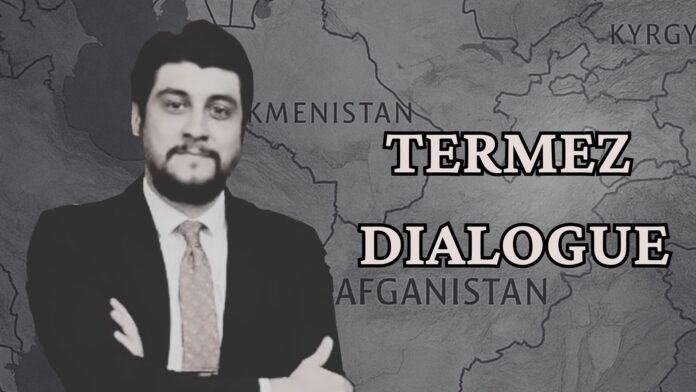In the latest Afghan Eye Podcast episode, host Sangar Paykhar speaks to Eurasian analyst Eldaniz Gusseinov about the inaugural Termez Dialogue in southern Uzbekistan, exploring Afghanistan’s role in regional geopolitics.
Advancing Afghanistan’s Geopolitical Standing
In late May 2025, the inaugural Termez Dialogue convened in Termez, Uzbekistan, signalling a shift in regional geopolitics. Eldaniz Gusseinov highlights that Russia’s formal recognition of Afghanistan’s de facto authorities reflects Moscow’s strategic need to diversify partnerships amid its engagement in the Ukraine conflict.
China, too, has signalled keen interest in expanding its influence through the Middle Corridor. Gusseinov explains that Beijing hopes to secure overland energy and logistics routes that bypass maritime chokepoints.
India and Pakistan remain cautious. Islamabad’s security establishment monitors potential cross-border militancy, whereas New Delhi weighs how enhanced connectivity could rebalance influence in South Asia. Both capitals participated diplomatically but with reserved enthusiasm.
Gusseinov and Paykhar argue that the Termez Dialogue demonstrates a departure from the conventional aid paradigm. Regional states now approach engagement with Kabul as a matter of mutual investment, recognising Afghan labour and resources as essential to sustainable infrastructure and trade.
Transforming Trade: Corridors and Economic Integration
Participants at the Termez Dialogue outlined proposals for a network of rail and road corridors designed to integrate Afghanistan into Central Asian markets. Key schemes include a north–south rail link from Mazar-i-Sharif through Hairatan into Uzbekistan and an east–west connection from Herat to Iran’s rail network.
The planned Kabul–Peshawar railway, as well as upgrades to the Kabul–Mazar highway, would position Afghanistan as a vital transit hub between South and Central Asia. Gusseinov notes that such infrastructure could reduce transport costs by up to 30 per cent and stimulate regional trade flows.
During the Termez Dialogue, energy integration emerged as another pillar. The Turkmenistan–Afghanistan–Pakistan–India (TAPI) gas pipeline and the CASA-1000 electricity transmission project featured prominently, underscoring shared interests in energy security and grid stability. Gusseinov recommends a format of workgroups where all stakeholders come together on regular basis to formulate joint agreements on these matters.
Afghan resources, from lithium deposits to agricultural produce, offer lucrative export opportunities for neighbouring states. Gusseinov stresses that framing these ventures as joint ventures rather than aid projects will attract private investment and foster local entrepreneurship.
Economic integration, he concludes, depends not only on physical connectivity but also on harmonised customs procedures and regulatory frameworks.
Cultural and Historical Connectivity
A visit to the archaeological museum in Termez provided tangible evidence of Central Asia’s pre-modern connectivity. Relics from Greco-Bactrian sites in northern Afghanistan highlight an era when Mazar-i-Sharif and Samarkand formed part of a contiguous cultural space.
Paykhar critiques modern ancestry tests that purport to trace genetic lineages across Central and South Asia. He argues that shared languages, religious practices and artisanal traditions better reflect millennia of exchange than genomic snippets.
Diaspora networks further illustrate this cultural continuity. In Almaty bazaars, Afghan traders sell embroidered caps and scarves, while “Afghan Pepsi” has gained popularity among Muslim consumers as a certified halal beverage. These exchanges foster people-to-people ties that underpin wider regional cooperation.
Water Management and Environmental Security
Water management features as a critical theme in this episode. Kabul’s ageing supply network, originally designed for 700,000 residents, now serves over six million, leading to chronic shortages and unregulated well-drilling that depletes urban aquifers.
Upstream dam construction on Afghan rivers risks reducing flow into Turkmenistan, Uzbekistan, Iran and Pakistan. Gusseinov warns that uncoordinated development could spark “water wars” unless addressed through legal and technical frameworks.
Climate change compounds these challenges. Glacial retreat in the Pamir and Hindu Kush regions has already altered seasonal water availability, affecting both agriculture and hydropower projects. Without robust adaptation measures, rural livelihoods remain precarious.
Gusseinov urges Afghanistan to join existing Central Asian water treaties and to establish a binding water-sharing agreement. Transparent data-sharing on river flows and reservoir levels, managed by a joint commission, would build trust and protect downstream communities.
Recommendations for Future Conference Organisers
Gusseinov set out several concrete recommendations for organisers of future Termez Dialogue forums:
-
Institutionalisation: Convene the dialogue annually under Uzbek auspices to ensure continuity and monitor progress on commitments.
-
Thematic Working Groups: Create expert clusters on water management, infrastructure connectivity and security cooperation with clear mandates and timelines.
-
Legal Frameworks: Facilitate Afghanistan’s accession to regional water-sharing treaties and draft supplementary protocols recognising both upstream rights and downstream obligations.
-
Financing through the SCO: Utilise the Shanghai Cooperation Organisation’s resources and framework to fund the Termez Dialogue’s institutionalisation, working groups and pilot projects.
-
Pilot Initiatives: Implement cross-border pilot projects, such as climate-resilient irrigation and heritage tourism circuits, to demonstrate tangible benefits and foster trust.
-
Investment Narrative: Shift public discourse from aid dependency to mutual investment, emphasising joint ventures that leverage Afghan resources, Central Asian capital and diaspora expertise.

